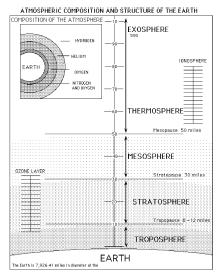|
This section contains 361 words (approx. 2 pages at 300 words per page) |
The atmosphere is the envelope of gas surrounding the earth, which is for the most part permanently bound to the earth by the gravitational field. It is composed primarily of nitrogen (78% by volume) and oxygen (21%). There are also small amounts of argon, carbon dioxide, and water vapor, as well as trace amounts of other gases and particulate matter.
 (Illustration by Hans & Cassidy.)
(Illustration by Hans & Cassidy.)
Trace components of the atmosphere can be very important in atmospheric functions. Ozone accounts on average for two parts per million of the atmosphere but is more concentrated in the stratosphere. This stratospheric ozone is critical to the existence of terrestrial life on the planet. Particulate matter is another important trace component. Aerosol loading of the atmosphere, as well as changes in the tiny carbon dioxide component of the atmosphere, can be responsible for significant changes in climate.
The composition of the atmosphere changes over time and space. Outside of water vapor (which can vary from 0–4% in the local atmosphere) the concentrations of the major components varies little in time. Above 31 mi (50 km) from sea level, however, the relative proportions of component gases change significantly. As a result, the atmosphere is divided into two compositional components: Below 31 mi (50 km) is the homisphere and above 31 mi (50 km) is the heterosphere.
The atmosphere is also divided according to its thermal behavior. By this criteria, the atmosphere can be divided into several layers. The bottom layer is the troposphere; it contains most of the atmosphere and is the domain of weather. Above the troposphere is a stable layer called the stratosphere. This layer is important because it contains much of the ozone which filters ultraviolet light out of the incident solar radiation. The next layer, is the mesosphere, which is much less stable. Finally, there is the thermosphere; this is another very stable zone, but its contents are barely dense enough to cause a visible degree of solar radiation scattering.
Resources
Books
Anthes, R. A., et al. The Atmosphere. 3rd ed. Columbus, OH: Merrill, 1981. Schaefer, V., and J. Day. A Field Guide to the Atmosphere. New York: Houghton Mifflin, 1981.
Periodicals
Graedel, T. E., and P. J. Crutzen. "The Changing Atmosphere." Scientific American 261 (September 1989): 58–68.
|
This section contains 361 words (approx. 2 pages at 300 words per page) |


